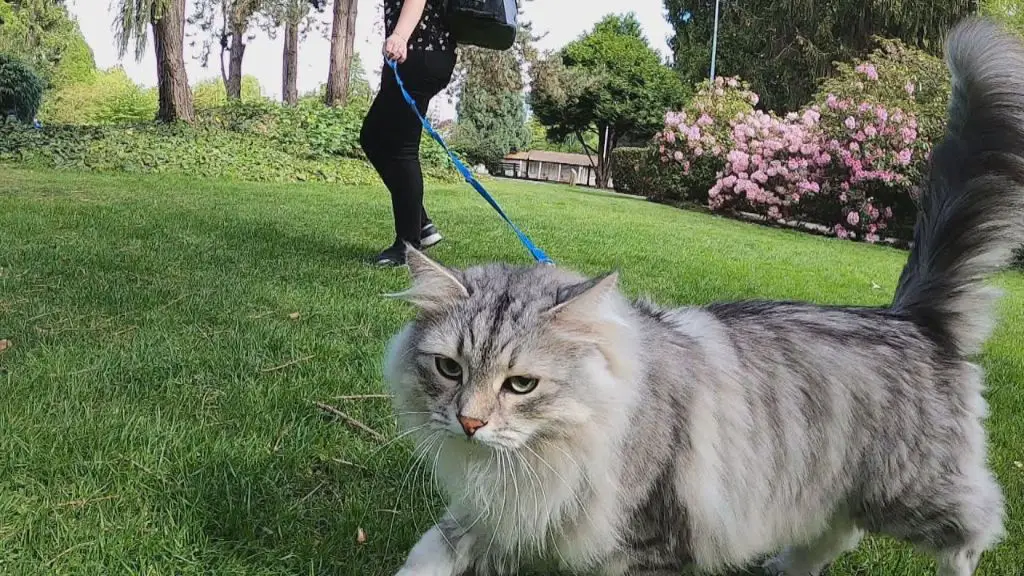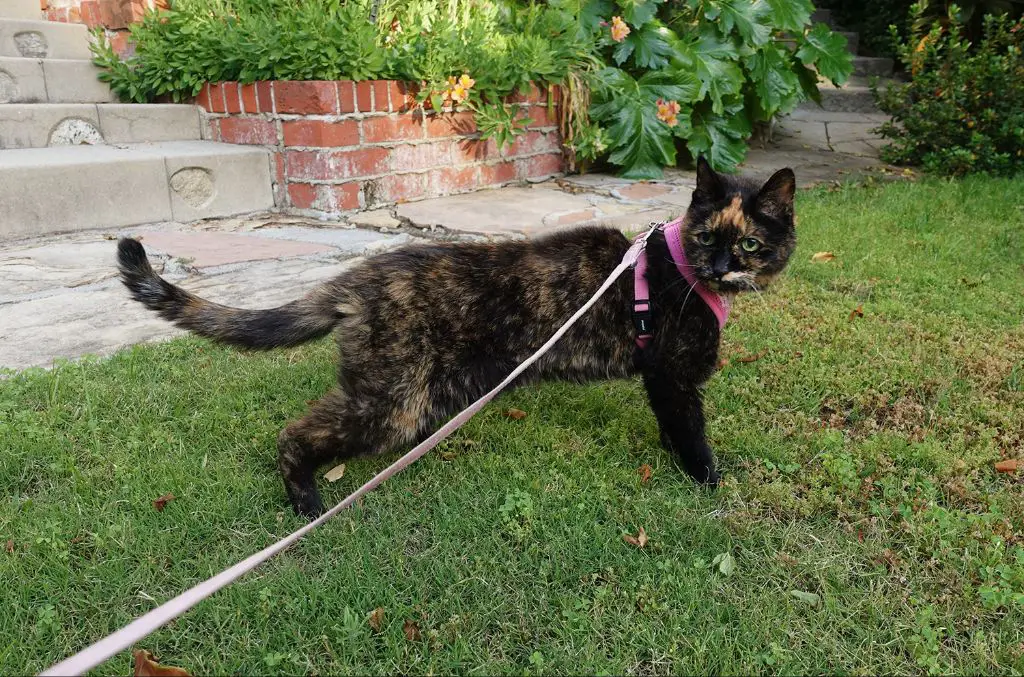Walking your cat on a leash provides many benefits for both you and your feline companion. According to Jackson Galaxy, leash-walking gives cats much-needed exercise and mental stimulation from exploring the outdoors using their heightened senses. It also allows you to spend quality time with your cat and strengthens your bond. Other sources like Petsmont note leash-walking is fun for cats, improves their mood and mental state, and doesn’t reduce their life expectancy like letting them roam freely would. With some patience and training, walking your cat can be an enriching experience for both of you.
Get the Right Equipment
When it comes to leash training cats, using the proper equipment is essential for keeping your cat comfortable and secure. The most important pieces of gear are the harness and leash designed specifically for cats.

There are a few types of cat harnesses to choose from:
- Vest/jacket harnesses provide more coverage and may feel more secure for some cats.
- H-style harnesses wrap around the chest and shoulders.
- Figure 8 harnesses go around the neck and chest.
Look for a well-fitted harness made of lightweight, breathable material that fastens securely but does not rub or pinch. Adjustable straps help get the proper fit. Most cat harnesses attach via quick release buckles or plastic clasps.
For the leash, a standard 4-6 foot leash is usually best. Some cat leashes have elastic built in to provide some bounce and flex. Select a leash width and material that is comfortable for you to hold and control.
It’s also a good idea to get an ID tag with your cat’s name and your phone number in case your cat accidentally slips out of the harness.
Once you have the gear, take the time to gradually get your cat accustomed to wearing the harness and leash before venturing outdoors. With the right introduction and positive reinforcement, most cats can learn to enjoy walking on a leash.
Sources:
https://www.lemon8-app.com/bellothetabby/7230615905352319494?region=sg
https://www.lemon8-app.com/firegirl145/7226811607341351430?region=us
Let Your Cat Get Used to the Harness

A key part of training your cat to walk on a leash is getting them accustomed to wearing the harness comfortably. Most cats will resist a harness at first since it feels foreign on their body. Be patient and take it slow to help them adjust. Here are some tips:
Place the harness on your cat for short periods, like 5-10 minutes, a few times a day. Give them treats and praise so they associate the harness with positive rewards. Gradually increase the length of time wearing the harness as your cat seems more relaxed.
Make sure the harness fits properly – snug but not too tight. Check for rubbing that may irritate your cat’s skin. Adjust loose straps for a more secure fit. Get your cat used to you handling the harness buckles and straps.
Try distracting your cat when first putting on the harness with a toy or special food. This shifts their focus away from the unfamiliar sensation of the harness.
Start harness training with a kitten or younger cat. Older cats tend to be more resistant. But be patient and any cat can learn in time.
At first keep leash sessions very brief, even just holding out the leash without walking. As your cat seems comfortable wearing the harness while stationary or moving slightly, then start taking short walks.
Make sure your cat’s first leash is a lightweight model. After they are used to walking outside, you can consider a heavier duty harness for cats that try to escape or slip out of a standard leash. Check out brands like Petco for escape-proof cat walking harnesses.
Start Indoors and Slowly
When first introducing your cat to leash training, it’s best to start indoors in a familiar environment. Being inside minimizes outside distractions and keeps your cat feeling secure. Begin by simply attaching the leash to your cat’s harness and letting them walk around the house with it trailing behind them. This allows them to get used to the feeling of the leash without any tension or pulling. Give your cat treats and praise when they walk calmly with the leash attached.
After a few days of this, pick up the end of the leash and loosely hold it as you follow behind your cat. Continue rewarding calm behavior and don’t place any pressure on the leash. The goal is to get your cat comfortable with you holding the leash as they explore. Take it very slowly – just 5-10 minutes per session in the beginning. Any signs of stress or resistance means you should slow down. With positive reinforcement and patience, your cat will get accustomed to you holding the leash indoors first.
Once your cat seems at ease being led around the house on a loose leash, you can start gently guiding them in different directions using small tugs and treats. Keep sessions short and don’t force them. Your cat is ready for the next step when they reliably follow the leash prompts without fear or resistance.
Move to a Contained Outdoor Area
Once your cat is comfortable walking around indoors with the leash and harness, it’s time to move to a contained outdoor area like a fenced yard or enclosed porch. This allows your cat to start getting used to being outside on the leash, while still in a safe, enclosed space.
Make sure the area is fully secured with a tall fence or screens to prevent escape. You want your cat to feel comfortable exploring the new sights and sounds of the outdoors without the risk of bolting.
Bring your cat to the enclosed area and let them walk around slowly on the leash and harness. Keep the lead loose but don’t drop it completely yet. Stay close by and reward calm, confident behavior with treats and praise.
Spend short sessions of 5-10 minutes at first, then slowly increase the time as your cat adjusts. Providing interactive toys can help keep your cat engaged. Place your cat back indoors if they seem scared, overstimulated or try to escape.
With patience and repetition, your cat will learn to feel at ease walking on leash in the great outdoors!
Take Short, Positive Walks

When first starting leash training, it’s important to keep walks short and positive. This helps create good associations for your cat between the leash and going outside. Aim for 5-10 minute sessions in the beginning. Don’t force your cat to walk long distances right away, as this can overwhelm them.
During these short walks, be sure to use lots of encouragement and rewards. Give your cat treats and praise for any forward movement or positive behavior. If they freeze or seem unsure, don’t force them. Instead, try coaxing them with toys or treats. End each short session on a good note before your cat gets frustrated.
With daily practice of short, rewarding walks, your cat will gain confidence and learn that the leash means fun outdoor adventure. Over time, you can gradually increase the duration as your cat is ready. But keep those first walks short and sweet.
For more details, check out this article on initial leash training: [https://www.adventurecats.org/backcountry-basics/train-your-cat-to-walk-on-a-leash/]
Be Patient and Persistent
Leash training a cat takes time and continued practice. You’ll need to work with your cat daily, in short sessions, over the course of many weeks or months. Don’t get discouraged if your cat doesn’t take to the leash right away. With patience and persistence, you can teach even the most stubborn cat to walk nicely on a leash.
Set aside 5-10 minutes per day for dedicated leash training. Keep training sessions positive and reward your cat frequently. If your cat becomes frustrated, go back to an earlier step in training until they regain confidence. Celebrate small successes and don’t force your cat beyond their limits.
Over time, as you continue daily practice, your cat will get more comfortable walking on the leash. They’ll learn that the leash means fun outdoor adventures with you. Be patient during setbacks and keep rewarding wanted behaviors. With routine training, even an older cat can learn this new skill.
Use Commands and Rewards
An essential part of training your cat to walk on a leash is teaching basic cues like “come” and “stay.” This establishes you as the leader during walks and gets your cat used to responding to commands. Always use positive reinforcement methods with food rewards.
Start inside your home and designate a specific, consistent word for each cue. For “come,” call your cat’s name and say “come” in an upbeat, encouraging tone when they walk toward you. Immediately reward with a tasty treat. For “stay,” have your cat sit and hold a hand up while saying “stay.” Take a few steps back and then reward if they remain in place. Build up duration gradually.
According to pet experts, other helpful commands include “watch me” to gain focus, “touch” for targeting your hand, and “let’s go” to initiate movement. Avoid punishment, frustration, or physically forcing your cat. Stay upbeat and patient. Consistency and repetition are key. Cats learn much through observation as well, so demonstrate desired behaviors.
During walks, use “come” if your cat lags behind and “let’s go” to coax movement. Praise and give treats for compliance. With enough practice, your cat will respond reliably on leash to these cues. Make training fun and be sure to monitor your cat for signs of stress like crouching or swishing tail.
Troubleshoot Misbehavior
Cats may exhibit some unwanted behaviors when first learning to walk on a leash. Here’s how to troubleshoot some common issues:
Pulling on the Leash
If your cat tries to pull on the leash or run off, stop immediately and don’t let them get away with it. Give a firm “no” command and turn and walk in the opposite direction. This teaches your cat that pulling gets them nowhere. Reward your cat with treats and praise when they walk politely beside you without pulling.
You can also try distracting your cat from pulling by getting their attention back on you. Wave a toy in front of them or make an exciting clicking sound with your tongue. When they stop pulling and look at you, reward them right away.
Be patient, as this takes time for a cat to understand. Cats want to explore, so expect them to try bounding ahead. Stay calm and consistent with your training.
Safety Tips
When walking your cat outside, it’s important to take safety precautions to protect your cat. Here are some tips:

- Be aware of your surroundings. Look out for other dogs, cats, or wildlife that could startle or threaten your cat. Keep your distance.
- Avoid areas with busy roads. The sights and sounds could frighten your cat.
- Don’t let your cat approach unknown animals or people. Begin socialization slowly.
- Use a well-fitted harness and leash designed for cats to prevent escapes.
- Start in your own yard or driveway at first before venturing further.
- Keep your cat away from toxic plants and flowers. Cats may try to nibble or play with them.
- Bring water on longer walks to keep your cat hydrated.
- Walk earlier or later in the day when it’s cooler if it’s hot outside.
- Keep walks short at first, less than 15 minutes, until your cat is comfortable.
- Carry your cat’s ID tag and consider microchipping in case of escapes.
Taking precautions can help make outdoor leash walks safe, enriching experiences for you and your cat. Go at your cat’s pace and avoid overstimulation or stressful situations.

